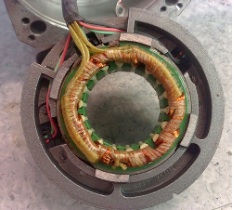Myostat
Position Feedback Components

While most motion control systems can work with either resolvers or encoders to monitor shaft position, they are not interchangeable. Many engineers are unfamiliar with resolver electronics and opt for an optical encoder as a default. As with all components, it is important to understand the basic operation of both options and keep abreast of technological advances to build the most efficient and effective systems.
Both resolvers and optical encoders function as transducers by transforming mechanical motion into electronic information. This information is fed back to electronic devices that control the mechanical motion, providing feedback that closes the control system loop and improves system performance.
A resolver is an electromechanical device with a mechanical design similar to a motor or a small transformer. It contains a rotor with one or two orthogonal primary windings and a stator with two orthogonal secondary windings. AC voltage is applied to the rotor and the voltage induced in each stator winding depends on the position of the shaft.
The voltage in one stator winding is Er Cos theta, where Er is the input voltage and theta is the shaft position, while the voltage in the other stator winding is Er Sin theta. A resolver-to-digital converter (generally mounted in the equipment to which the resolver is connected) compares the two voltages to give a highly accurate value of theta.
The biggest upside to resolvers is their ruggedness. They are resistant to electrical disturbances and, because they have no fine-pitch gratings through which light must pass, they can tolerate dust and dirt that would stop an encoder.
In contrast, an optical encoder uses a scale with a pattern of lines deposited or engraved on its surface. A light source shines on the scale, and the transmitted or reflected light passes through the grating to a photodetector.
Encoders are available with both incremental and absolute outputs. An absolute encoder has as many tracks as it has output bits. An incremental encoder outputs a stream of pulses as the shaft rotates and are specified in pulses per revolution (ppr). Incremental encoders can be optical, using a scale or disk with just one or two rows, or magnetic, using several different technologies.
An incremental encoder does not provide any position information at start-up, but merely keeps track of how far it has moved. The only way to determine the absolute position of an incremental encoder is to set the equipment to a known reference position and then zero the counters.
Unlike a resolver, encoders are intrinsically digital, which means they can interface easily to most modern control systems. However, optical encoders have had a reputation for being fragile. The thin glass disk at the heart of most optical encoders could be broken by excessive shock or misaligned by strong vibration. In addition, their integrated circuits could be damaged by a severe electrical disturbance or they could be obscured by dirt. Over the last decade, encoders gained popularity as the glass disks were replaced with steel and plastic disks and the electronics became more integrated and durable as a result.
Resolvers have also undergone a transformation in the past few years, which affects the way engineers are thinking about them. Advances in electronics manufacturing have lowered the cost of circuits and provide an increase in resolution. In fact, 21 byte resolvers are now available with more than 2 million ppr.
Resolvers are also gaining exposure through their use in automotive and green energy applications that deal with environmental exposure. Compared to optical encoders, resolvers are far more durable in extreme conditions, operate under greater temperature ranges, tolerate higher vibrations and are not as easily degraded by contamination. For these reasons, resolvers excel in modern application positioning feedback for hybrid vehicle electrical mechanical components and solar panel positioning systems.
This article originally appeared in the March/April Issue of Design Engineering Magazine
Mark McCann is the Lead Design Engineer at automation solutions provider, Myostat Motion Control. During his eight years with the company, Mark has worked on hardware, electronic circuit design, software, microcontroller firmware development and windows application programming.